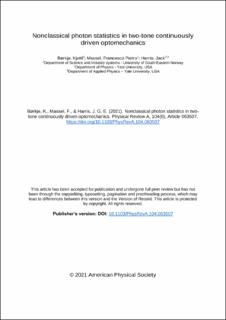| dc.contributor.author | Børkje, Kjetil | |
| dc.contributor.author | Massel, Francesco Pietro | |
| dc.contributor.author | Harris, Jack | |
| dc.date.accessioned | 2022-01-07T11:46:36Z | |
| dc.date.available | 2022-01-07T11:46:36Z | |
| dc.date.created | 2021-12-13T09:14:47Z | |
| dc.date.issued | 2021 | |
| dc.identifier.citation | Børkje, K., Massel, F., & Harris, J. G. E. (2021). Nonclassical photon statistics in twotone continuously driven optomechanics. Physical Review A, 104(6), Artikkel 063507. | en_US |
| dc.identifier.issn | 2469-9926 | |
| dc.identifier.uri | https://hdl.handle.net/11250/2836489 | |
| dc.description.abstract | In cavity optomechanics, single-photon detection of Raman scattered photons can be a useful tool for observing nonclassical features of both radiation and motion. While this tool has been employed in experiments with pulsed laser driving of a cavity mode, it has not been readily accessible to experiments with continuous and constant laser driving. To address this, we present a study of a standard optomechanical system where the cavity mode is continuously driven at two different frequencies and where sideband photons are detected by single-photon detectors after frequency filtering the output from the cavity mode around its resonance frequency. We first derive the normalized second-order coherence associated with the detected photons and show that it contains signatures of the quantum nature of the mechanical mode which would be absent with only single-tone driving. To identify model-independent nonclassical features, we derive two inequalities for the sideband photon statistics that should be valid in any classical model of the system. We show that these inequalities are violated in the proposed setup. This is provided that the average phonon occupation number of the mechanical mode is sufficiently small, which in principle can be achieved through sideband cooling intrinsic to the setup. Violation of the first inequality means that there is no well-defined probability distribution of the Glauber-Sudarshan type for the cavity mode. In contrast, a violation of the second inequality means that there is no joint probability distribution for the cavity mode at two times separated by a finite interval, which originates from the noncommutativity of the motional quadratures of the mechanical mode. The proposed setup thus employs a mechanical oscillator in order to generate a steady-state source of nonclassical radiation. | en_US |
| dc.language.iso | eng | en_US |
| dc.title | Nonclassical photon statistics in two-tone continuously driven optomechanics | en_US |
| dc.type | Peer reviewed | en_US |
| dc.type | Journal article | en_US |
| dc.description.version | acceptedVersion | en_US |
| dc.rights.holder | © 2021 American Physical Society | en_US |
| dc.source.volume | 104 | en_US |
| dc.source.journal | Physical Review A (PRA) | en_US |
| dc.source.issue | 6 | en_US |
| dc.identifier.doi | https://doi.org/10.1103/PhysRevA.104.063507 | |
| dc.identifier.cristin | 1967575 | |
| dc.source.articlenumber | 063507 | en_US |
| cristin.ispublished | true | |
| cristin.fulltext | postprint | |
| cristin.qualitycode | 2 | |
